Gatehouse – Gannett Merger Approved
Skip to commentsShareholders have approved the merger of Gatehouse (New Media) and Gannett.
Below are some outtakes of the Rick Edmonds article for Poynter:
The combination will take place Tuesday, Nov. 19.
The deal had been announced in mid-August as a $1.4 billion purchase of Gannett by New Media. But New Media shares have declined so much in the meantime (from $10.70 to $6.88) that the value of the transaction fell to $1.13 billion.
Big layoffs are looming as the combined company (to be called Gannett) attempts during the next several years to deliver a promised $275 million to $300 million in cost-saving synergies.
The larger challenge, though, may be to engineer a full transformation to digital news at its 266 daily outlets and create a widened digital revenue base.
Mike Reed, CEO of New Media and the merged company, said as the deal was announced that together the two companies now get 25 percent of their revenue from digital, the rest from print. That’s a long way to go.
Yesterday’s announcement said that together the two companies have been growing paid digital subscriptions and now have 824,000. Spread over 250-plus properties, that is a little more than 3,000 each.
Gannett’s flagship USA Today presents a special problem. Throughout its history, the USA Today site has been free. There are opportunities to charge for premium-level membership or for a vertical site — for instance, covering a sport or team. But flipping a switch to turn from free to paid would drastically disrupt traffic to the main USA Today site.
At both companies (as throughout the industry) newsroom staffs have been reduced as revenues and profits contract. That is particularly true in the smallest markets. Sources have told me that at each company at least a third of the titles are so-called “ghost newspapers” with as few as one, two or three locally based reporters or editors.
As I wrote in a preview report Wednesday on the merger, staff reductions including newsroom cuts are imminent with another round planned for early 2020. I was told today that the first of these have now been pushed to the first week in December.
At Nieman Lab Ken Doctor looks at the merger, excerpts:
Follow the money: When I first wrote about this potential union back in July, the estimated annual cost savings — “synergy” — to be derived from a merger was “something like $200 million.” By August, it was “$200 to 300 million.” Then it was “$275–300 million.” Now, talk has gone to $400 million and beyond, into the range of nearly half a billion dollars.
What does that mean? Almost certainly, even more reduction in headcount than had been anticipated. (Executives declined to comment on the amount the synergies they’re now eyeing.)
They approved the deal despite the value of the deal plummeting since it was first announced. On that day in August, NEWM shares stood at $10.70. At market close yesterday, they’d dropped to $6.68, including a six percent decline on Wednesday alone. The deal originally valued at $1.38 billion is now worth $1.13 billion.
Why the drop? Some investors looking at the deal had hoped it would fail and thought they could catch a NEWM bounce; perhaps some abandoned the stock as the merger became a near-certainty. Perhaps you can blame McClatchy, the next largest newspaper chain, for souring the market; its stock dropped 12 percent yesterday after it announced that the IRS had denied its request for pension fund funding relief. (It’s down 22 percent since Friday.)
This wasn’t the beginning of The Merging, and Doctor reveals it isn’t the end:
Actually, let’s start with some news: the next big newspaper M&A deal, which I can now report is (once again) in progress. McClatchy and Tribune executives are talking about merging their two companies, I’ve confirmed with several sources. While I don’t expect any imminent announcements, both companies’ executives agree that, in this rapidly deteriorating operating environment, a merger that buys time by massively cutting costs is a first order of 2020 business.
Put it all together and the 2019 Consolidation Games, first previewed here in January, are set to extend into the new decade.
Back to Gatehouse/Gannettt:
Though Reed has said editorial cuts would be minimal, “there’s no way they can get that number without significant newsroom cuts,” one person very close to the deal told me. Other sources have echoed that belief. With headcount amounting to about 50 percent of total expense, most are placing the overall number of FTE cuts at more than 3,000. Some believe the number, over the next year, will come in at somewhere between 3,500 and 4,000. It’s unlikely we’ll know the actual number for awhile, and then only through extrapolation.
For a sense of scale, when this deal closes, McClatchy will be the second largest U.S. newspaper company by circulation, behind New Gannett. It has fewer than 2,800 employees in total. So New Gannett will cut more jobs — perhaps substantially more — than its biggest competitor even has.
And the future?:
No one loves this deal, but it is probably the best that can done now to possibly salvage investors’ stakes. That’s what I hear from those in and around it. For publicly traded, single-class newspaper companies — a species that night not survive the 2020s — it’s all about the art of the imminently possible.
Both Rick Edmunds’ and Ken Doctor’s pieces are interesting and good reading … and depressing.


Comments 1
Comments are closed.